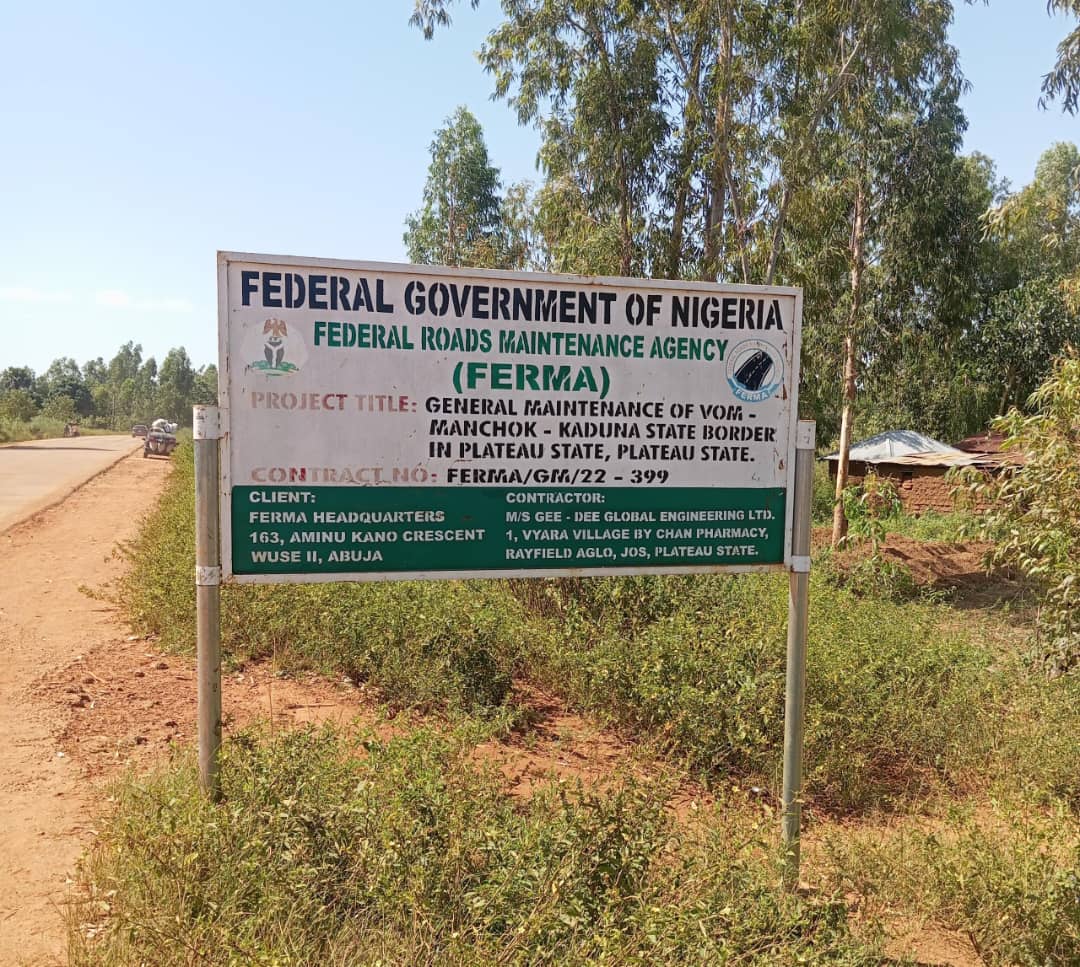INVESTIGATION: How Federal Government’s Abandonment of Strategic Manchok-Vom Road Strangles Economic Lifeline and Fuels Insecurity
By Steven Kefas
The sun beats down mercilessly on dozens of stranded vehicles along what should be one of Nigeria’s most vital economic arteries. For hours, commercial drivers, traders, and farmers have been trapped in a quagmire of mud, broken asphalt, and bureaucratic neglect that defines the current state of the Manchok-Ganawuri-Vom federal road.
This 52-kilometre stretch, designated as a federal highway, serves as a critical economic lifeline connecting Plateau State with Kaduna and numerous neighboring states across Nigeria’s Middle Belt region. Yet today, it stands as a monument to governmental abandonment and institutional failure.
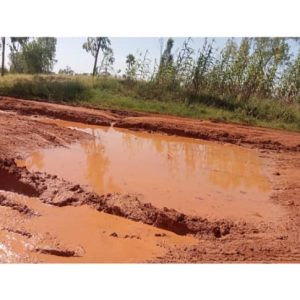
The communities dotting this strategic corridor are among Nigeria’s most productive agricultural zones. Farmers here cultivate vast quantities of yam, maize, rice, potatoes, and ginger – crops that feed millions across the country. However, the deplorable condition of their primary route to market has transformed what should be prosperity into a daily nightmare of economic losses and human suffering.
“We produce enough food to feed millions of Nigeria, but we cannot get our harvest to the people who need it,” laments Musa Ibrahim, a farmer from Ganawuri whose truck loaded with yams overturned last month, destroying produce worth over 3 million naira.
The economic implications extend far beyond individual losses. Trucks carrying goods such as bottled drinks, water etc worth millions of naira regularly topple over on the treacherous terrain, their cargo spilling into roadside ditches where it rots under the elements. The ripple effects reach urban markets in Jos, Kaduna, and Abuja, where food prices continue to soar partly due to transportation challenges from these productive farming communities.
Perhaps the most insulting aspect of this crisis is the massive signpost erected by the Federal Road Maintenance Agency (FERMA) boldly declaring that the Manchok to Vom Junction stretch has been “rehabilitated.” This gigantic billboard stands as a cruel joke to daily road users who navigate crater-sized potholes and impassable mud pools.
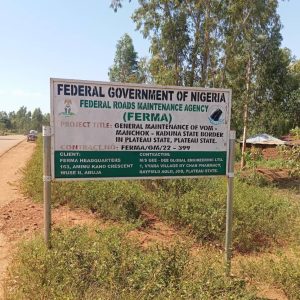
All efforts to reach FERMA for comments on the road’s condition and their maintenance claims proved unsuccessful. Multiple phone calls to the two contact numbers listed on the agency’s official website went unanswered, while a text message sent seeking their response was never replied to.
A closer examination reveals the truth behind FERMA’s claims. While minor patch work was indeed carried out on sections with small potholes, the Ganawuri portion – the most critical and severely damaged section – remains completely untouched. It is a classic case of cosmetic intervention designed more for political optics than genuine infrastructure development.
The agency’s selective rehabilitation approach has created an even more dangerous situation. Drivers, encouraged by the initial smooth patches, accelerate into what becomes a vehicular trap at Ganawuri, where the road deteriorates so dramatically that vehicles frequently get stuck for entire days.
The federal government’s neglect has created an unprecedented situation where local youths have essentially privatized a federal highway. Young men from Ganawuri now control access to the most treacherous sections, strategically placing rocks across deep craters and charging motorists 500 naira for the privilege of attempting passage.
During this reporter’s investigation on Wednesday, August 27, the situation had reached absurd proportions. After paying 1,000 naira through mobile transfer for road access, this correspondent joined dozens of other vehicles in a hours-long traffic standstill that stretched for about 1 kilometre.
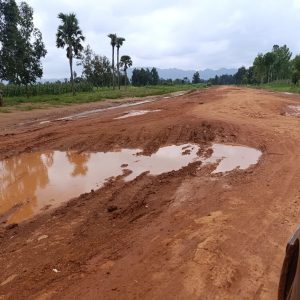
The scene resembled a refugee camp more than a major highway. Frustrated passengers had disembarked, seeking shade that did not exist on the road. Hawkers moved through the stationary traffic selling water, sugarcane, and snacks to stranded travelers. Mothers with crying babies pleaded with drivers to somehow find alternative routes that simply do not exist.
The agricultural community has been forced to adapt in ways that highlight the severity of the situation. Farmers who once loaded their produce onto trucks for efficient transport to distant markets now depend entirely on motorcycles for their logistics chain.
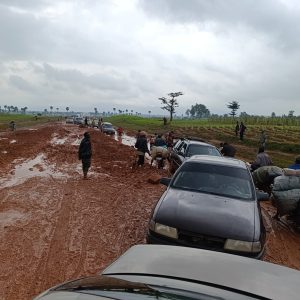
“I used to send bags of potatoes to Kaduna and Abuja markets in one trip,” explains Rebecca Dung, a potato farmer in the area. “Now I can only send two bags at a time on a motorcycle, and the transport cost has tripled. Many of us are considering abandoning farming altogether because we cannot transport our potatoes to the market and they go bad after a few days”
This shift from truck-based to motorcycle-based transportation has reduced agricultural efficiency by approximately 80 percent while increasing costs exponentially. The knock-on effects include reduced agricultural investment, lower crop cultivation, and ultimately, decreased food security for the broader region.
Commercial drivers operating along this route have become unwilling martyrs to federal government negligence. Michael Adamu, who has been plying this route for over a decade, provides a heartbreaking testimony of occupational hazard that no professional should endure.
“Any time I manage to pass this road with passengers during the rainy season like this, I have to go straight to the mechanic workshop,” Adamu reveals, his voice heavy with frustration. “We are suffering here as you can see, we have been here for several hours and don’t know when we will move. The government must do something about this road.”
His experience is not unique. Conversations with multiple commercial drivers reveal a pattern of vehicle damage, increased maintenance costs, and lost income that threatens their livelihoods. Some road users have developed back and joint problems from navigating the rough terrain, while others have abandoned the route entirely, reducing transportation options for rural communities.
The road’s deplorable condition has created a security vacuum that armed militants and criminals exploit with devastating consequences. Habu Lucky, a local vigilante member in Ganawuri, articulates a reality that government security strategists seem to have ignored completely.
“As you can see, the condition of this road also makes it difficult for security response. Even if there is a security challenge, how do you think security personnel can access the communities? Tell me,” he challenges, gesturing toward the impassable terrain.
His concerns proved tragically prophetic on December 22, 2024, when armed Fulani militants attacked Gidan Ado community in Ganawuri chiefdom, Riyom Local Government Area. Fourteen people, including a pregnant woman, were killed in an attack that security forces struggled to respond to effectively due to the impassable road conditions.
The incident illustrates how infrastructure neglect becomes a national security threat. When government forces cannot reach crisis zones quickly, local communities become sitting targets for criminal elements who understand the terrain’s strategic advantages.
The Manchok-Ganawuri-Vom road crisis demands immediate federal intervention that goes beyond the superficial patch work that has characterized previous efforts. What is required is comprehensive reconstruction that acknowledges this route’s strategic importance to Nigeria’s food security and regional economic integration.
The federal government must treat this highway with the urgency it deserves – as a critical piece of national infrastructure whose failure threatens the economic survival of entire communities and the food security of millions of Nigerians.
Until then, farmers will continue watching their harvests rot, drivers will keep visiting mechanics after every journey, and communities will remain vulnerable to security threats that thrive in the shadow of governmental neglect.
The question remains: How long will the federal government allow one of Nigeria’s most productive regions to remain economically strangulated by a road that should be connecting communities, not isolating them?
This investigation was conducted over multiple visits to the Manchok-Ganawuri-Vom corridor, with extensive interviews of affected stakeholders including farmers, commercial drivers, local leaders, and security personnel.


